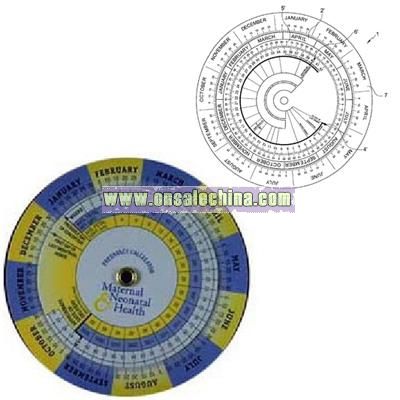This product is used to calculate the gestational age and prenatal care guidance, translation accuracy, easy to use, easy to carry, well received by doctors and the general consumers. Multiple locations can be printed LOGO, medical equipment, pharmaceutical products, brand promotion, business promotional products ideal.
Gestational calendar "wheels" are not well designed for routine prenatal care or for presenting the uncertainties of predicting date of delivery. OBJECTIVE OF PROGRAM: To design and pilot-test a new gestational calendar wheel that predicts the range of normal due dates in a way that reflects the biological realities of pregnancy. The calendar has prompts that could facilitate provision of antenatal care, support prenatal education, and guide the timing of induction for pregnancies past their due dates. MAIN COMPONENTS OF PROGRAM: The calendar sets out the key issues to be addressed with patients during pregnancy. It is designed to be photocopied while set to patients' dates: patients keep one copy; another is placed in their charts. The probability of delivering on a given date is presented graphically and as a percentage likelihood of giving birth during specified intervals. Twelve practising physicians, 12 residents, and 10 pregnant women pilot-tested and evaluated the wheel. Their responses were favourable. CONCLUSIONS: The Maternity Care Calendar wheel is a substantial advance on existing obstetric calendar wheels. It incorporates evidence-based information that should facilitate prenatal care, promote prenatal education, and foster realistic expectations about the likely timing of delivery. Early in the pregnancy, it can help establish the timing of induction for pregnancies past their due dates. Further testing of the calendar's effectiveness in improving patient outcomes is needed.
When set to a patient's dates, the face of the maternity calendar provides an "at-a-glance", individualized template outlining the timing of important interventions and key issues to be addressed during the pregnancy. Being photocopiable, dates can be set on the calendar and serve as a guide for the patient. A second photocopy can also be placed with the patient's chart to serve as a prompt for testing during the patient's pregnancy and avoid the need for repetitive date checking on the rotational calendar with each prenatal visit. Important facts can be highlighted on the calendar while unnecessary tests can be crossed off. Altogether, patients can plan important pregnancy milestones with their caregivers. Previous studies have shown that the traditional rotational calendar or pregnancy wheel used in doctors' offices typically have up to a 5-day error in calculated delivery dates. The Maternity Care Calendar on the other hand is engineered to make sure that it can accurately measuring the 280-day gestational period to within +/-1 day in non-leap years. Another important innovation of the Maternity Care Calendar is the presentation of likelihood of delivery in the event a woman has spontaneous onset of labour. The chance of delivery at various intervals around the dates of confinement are presented, de-emphasizing the relatively unimportant statistic of the mean due date. The Guidelines Checklist On the reverse side of the calendar and its wheel is a checklist of evidence-based maternity care guidelines. The guidelines are derived primarily from an extensive review of the Canadian Task Force on Preventive Health Care and the U.S. Preventative Services Task Force Reports, as well as MEDLINE searches on a number of topics. Clinical interventions, which received an A or B grade by either Task Force, are listed in bold type as recommendations. Those interventions that received a C grade, or are recommended by organizations not necessarily using the same rigorous criteria for reviewing the evidence, are listed in plain type for consideration. Recommended interventions are displayed along a timeline under 3 headings: Clinical Maneuvers, Investigations and Issues for Discussion. Interventions that should be considered preconception are shown in green. This one-page checklist can also be photocopied and incorporated in the patients chart to provide prompts for best care. Twelve practising physicians, 12 Family Practice Residents and 10 pregnant women pilot-tested and evaluated the Maternity Care Calendar and Guidelines Checklist. Their responses were favourable.
Further information about both the Maternity Care Calendar and Maternity Care Guidelines checklist can be found in the April 1999 edition of Family Matter's or the article published in the March 1999 edition of Canadian Family Physician. The Maternity Care Calendar and Guidelines Checklist from the March 1999 edition of Canadian Family Physician has just been added.
We hope that the providers of maternity care and their patients will find this tool helpful. We would be very pleased to receive your feedback. Yours sincerely, Stefan Grzybowski, MD
Colleen Kirkham, MD Women planning a pregnancy please use this link: Pregnancy Planning Guide
Customer's Design & Logo are welcome.
Maternity care calendar wheel / Obstetrics measure and calculator wholesale china



